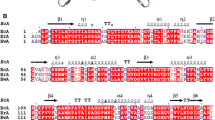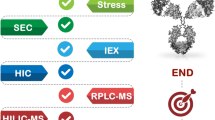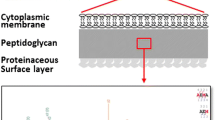Abstract
Purpose
Erwinia chrysanthemi L-asparaginase (ErA) is an enzyme commonly used in the treatment regimen for Acute Lymphoblastic Leukaemia (ALL). Biopharmaceutical products such as ErA must be monitored for modifications such as deamidation, typically using ion-exchange chromatography (IEX). Analysis of clinical-grade ErA using native IEX resolves a number of enzymatically-active, acidic variants that were poorly characterised.
Methods
ErA IEX variants were isolated and fully characterised using capillary electrophoresis (cIEF), LC-MS and LC-MS/MS of proteolytic digests, and structural techniques including circular dichroism, small-angle X-ray scattering (SAXS) and ion-mobility mass spectrometry (IM-MS).
Results
LC-MS, MS/MS and cIEF demonstrated that all ErA isolates consist mainly of enzyme lacking primary-sequence modifications (such as deamidation). Both SAXS and IM-MS revealed a different conformational state in the most prominent acidic IEX peak. However, SAXS data also suggested conformational differences between the main peak and major acidic variant were minor, based on comparisons with crystal structures.
Conclusions
IEX data for biopharmaceuticals such as ErA should be thoroughly characterised, as the most common modifications, such as deamidation, may be absent.









Similar content being viewed by others
Abbreviations
- AHA:
-
L-aspartic acid-β-hydroxamate
- ALL:
-
Acute Lymphoblastic Leukaemia
- CCS:
-
Collision Cross Section
- CD:
-
Circular Dichroism
- CID:
-
Collision-Induced Dissociation
- cIEF:
-
Capillary Isoelectric Focussing
- DP:
-
Drug Product
- DS:
-
Drug Substance
- EcA:
-
Escherichia coli L-asparaginase
- ErA:
-
Erwinia chrysanthemi L-asparaginase
- ESI:
-
Electrospray Ionisation
- HPLC:
-
High-Pressure Liquid Chromatography
- I(q):
-
Scattering Intensity
- IEX:
-
Ion-Exchange Chromatography
- IM-MS:
-
Ion Mobility-Mass Spectrometry
- LC-MS:
-
Liquid Chromatography-Mass Spectrometry
- LC-MS/MS:
-
Liquid Chromatography-Tandem Mass Spectrometry
- MES:
-
2-(N-morpholino)ethanesulfonic acid
- MS:
-
Mass Spectrometry
- MWCO:
-
Molecular Weight Cut-Off
- P(r):
-
Pair-Distance Distribution Function
- PBP:
-
Pheromone-Binding Protein
- PDB:
-
Protein Data Bank
- PTM:
-
Post-Translational Modification
- q:
-
Scattering Vector
- Rg :
-
Radius of Gyration
- SAXS:
-
Small-Angle X-ray Scattering
- SDS-PAGE:
-
Sodium Dodecyl Sulphate Polyacrylamide Gel Electrophoresis
- TOF:
-
Time-of-Flight
- UPLC:
-
Ultra High Pressure Liquid Chromatography
- Vc :
-
Volume of Correlation
- WT:
-
Wild-Type
- XIC:
-
Extracting Ion Current
References
Duval M, Suciu S, Ferster A, Rialland X, Nelken B, Lutz P, et al. Comparison of Escherichia coli–asparaginase with Erwinia-asparaginase in the treatment of childhood lymphoid malignancies: results of a randomized European Organisation for Research and Treatment of Cancer—Children’s Leukemia Group phase 3 trial. Blood. 2002;99(8):2734–9.
Beard MEJ, Crowther D, Galton DAG, Guyer RJ, Fairley GH, Kay HEM, et al. L-asparaginase in treatment of acute leukaemia and lymphosarcoma. Br Med J. 1970;1:191–5.
Pieters R, Hunger SP, Boos J, Rizzari C, Silverman L, Baruchel A, et al. L-Asparaginase treatment in acute lymphoblastic leukaemia: a focus on Erwinia asparaginase. Cancer. 2011;117(2):238–49.
Salzer WL, Asselin BL, Plourde PV, Corn T, Hunger SP. Development of asparaginase Erwinia chrysanthemi for the treatment of acute lymphoblastic leukemia. Ann N Y Acad Sci. 2014;1329:81–92.
Wriston JC. Asparaginase. Methods Enzymol. 1985;113:608–18.
Aghaiypour K, Wlodawer A, Lubkowski J. Structural basis for the activity and substrate specificity of Erwinia chrysanthemi L-Asparaginase. Biochemistry. 2001;40:5655–64.
Lubkowski J, Dauter M, Aghaiypour K, Wlodawer A, Dauter Z. Atomic resolution structure of Erwinia chrysanthemi L-asparaginase. Acta Crystallogr D. 2003;59:84–92.
Miller M, Rao JKM, Wlodawer A, Gribskov MR. A left-handed crossover involved in amidohydrolase catalysis: crystal structure of Erwinia chrysanthemi L-asparaginase with bound L-aspartate. FEBS J. 1993;328(3):275–9.
Gervais D, Allison N, Jennings A, Jones S, Marks T. Validation of a thirty-year-old process for the manufacture of L-Asparaginase from Erwinia chrysanthemi. Bioprocess Biosyst Eng. 2013;36(4):453–60.
Jenkins N, Murphy L, Tyther R. Post-translational modifications of recombinant proteins: significance for biopharmaceuticals. Mol Biotechnol. 2008;39(2):113–8.
Wang W. Protein aggregation and its inhibition in biopharmaceutics. Int J Pharm. 2005;289(1–2):1–30.
Manning MC, Chou DK, Murphy BM, Payne RW, Katayama DS. Stability of protein pharmaceuticals: an update. Pharm Res. 2010;27(4):544–75.
Liu DT. Deamidation: a source of microheterogeneity in pharmaceutical proteins. Trends Biotechnol. 1992;10:364–9.
Weitzhandler M, Farnan D, Rohrer JS, Avdalovic N. Protein variant separations using cation exchange chromatography on grafted, polymeric stationary phases. Proteomics. 2001;1:179–85.
Zhao SS, Chen DDY. Applications of capillary electrophoresis in characterizing recombinant protein therapeutics. Electrophoresis. 2014;35(1):96–108.
Yang H, Zubarev RA. Mass spectrometric analysis of asparagine deamidation and aspartate isomerization in polypeptides. Electrophoresis. 2010;31(11):1764–72.
Hao P, Ren Y, Datta A, Tam JP, Sze SK. Evaluation of the effect of trypsin digestion buffers on artificial deamidation. J Proteome Res. 2015;14(2):1308–14. doi:10.1021/pr500903b.
Farnan D, Moreno GT. Multiproduct high-resolution monoclonal antibody charge variant separations by pH gradient ion-exchange chromatography. Anal Chem. 2009;81(21):8846–57.
Rea JC, Moreno GT, Lou Y, Farnan D. Validation of a pH gradient-based ion-exchange chromatography method for high-resolution monoclonal antibody charge variant separations. J Pharm Biomed Anal. 2011;54(2):317–23.
Han M, Guo A, Jochheim C, Zhang Y, Martinez T, Kodama P, et al. Analysis of glycosylated type II interleukin-1 receptor (IL-1R) by imaged capillary isoelectric focussing (i-cIEF). Chromatographia. 2007;66:969–76.
Sosic Z, Houde D, Blum A, Carlage T, Lyubarskaya Y. Application of imaging capillary IEF for characterisation and quantitative analysis of recombinant protein charge heterogeneity. Electrophoresis. 2008;29:4368–76.
Gandhi S, Ren D, Xiao G, Bondarenko P, Sloey C, Ricci MS, et al. Elucidation of degradants in acidic peak of cation exchange chromatography in an IgG1 monoclonal antibody formed on long-term storage in a liquid formulation. Pharm Res. 2012;29:209–24.
Khawli LA, Goswami S, Hutchinson R, Kwong ZW, Yang J, Wang X, et al. Charge variants in IgG1: isolation, characterisation, in vitro binding properties and pharmacokinetics in rats. MAbs. 2010;2(6):613–24.
Gervais D, O’Donnell J, Sung M, Smith S. Control of process-induced asparaginyl deamidation during manufacture of Erwinia chrysanthemi L-asparaginase. Process Biochem. 2013;48(9):1311–6.
Gervais D, Foote N. Recombinant deamidated mutants of Erwinia chrysanthemi L-asparaginase have similar or increased activity compared to wild-type enzyme. Mol Biotechnol. 2014;56(10):865–77.
Gervais D, King D. Capillary isolelectric focussing of a difficult-to-denature tetrameric enzyme using alkylurea-urea mixtures. Anal Biochem. 2014;465:90–5.
Harms E, Wehner A, Jennings MP, Pugh KJ, Beacham IR, Röhm KH. Construction of expression systems for Escherichia coli asparaginase II and two-step purification of the recombinant enzyme from periplasmic extracts. Protein Expr Purif. 1991;2:144–50.
Derst C, Henseling J, Röhm KH. Probing the role of threonine and serine residues of E coli asparaginase II by site-specific mutagenesis. Protein Eng. 1992;5(8):785–9.
Pringle SD, Giles K, Wildgoose JL, Williams JP, Slade SE, Thalassinos K, et al. An investigation of the mobility separation of some peptide and protein ions using a new hybrid quadrupole/travelling wave IMS/oa-ToF instrument. Int J Mass Spectrom. 2007;261:1–12.
Sivalingam GN, Yan J, Sahota H, Thalassinos K. Amphitrite: a program for processing travelling wave ion mobility data. Int J Mass Spectrom. 2013;345:54–62.
Glatter O, Kratky O. Small-angle x-ray scattering. London: Academic; 1982. Chapter 28.
Feigin LA, Svergun DI. Structure analysis by small-angle x-ray and neutron scattering. New York: Plenum Press; 1987.
Rambo RP, Tainer JA. Characterising flexible and intrinsically unstructured biological macromolecules by SAS using the Porod-Debye law. Biopolymers. 2011;95(8):559–71.
Receveur-Brechot V, Durand D. How random are intrinsically disordered proteins? A small-angle scattering perspective. Curr Protein Pept Sci. 2012;13(1):55–75.
Durand D et al. NADPH oxidase activator p67(phox) behaves in solution as a multidomain protein with semi-flexible linkers. J Struct Biol. 2010;169(1):45–53.
Rambo RP, Tainer JA. Accurate assessment of mass, models and resolution by small-angle scattering. Nature. 2013;496:477–81.
Tian X, Langkilde AE, Thorolfsson M, Rasmussen HB, Vestergaard B. Small-angle x-ray scattering screening complements conventional biophysical analysis: comparative structural and biophysical analysis of monoclonal antibodies IgG1, IgG2, and IgG4. J Pharm Sci. 2014;103:1701–10. doi:10.1002/jps.23964.
Garst AD, Heroux A, Rambo RP, Batey RT. Crystal structure of the lysine riboswitch regulatory mRNA element. J Biol Chem. 2008;283(33):22347–51.
Guo W, West JM, Dutton AS, Tsuruta H, Kantrowitz ER. Trapping and structure determination of an intermediate in the allosteric transition of aspartate transcarbamoylase. Proc Natl Acad Sci U S A. 2012;109(20):7741–6.
Heck AJR. Native mass spectrometry: a bridge between interactomics and structural biology. Nat Methods. 2008;5:927–33.
Thalassinos K, Pandurangan AP, Xu M, Alber F, Topf M. Conformational States of macromolecular assemblies explored by integrative structure calculation. Structure. 2013;21:1500–8.
Zhou M, Morgner N, Barrera NP, Politis A, Isaacson SC, Matak-Vinkovic D, et al. Mass spectrometry of intact V-type ATPases reveals bound lipids and the effects of nucleotide binding. Science. 2011;334:380–5.
Hilton GR, Thalassinos K, Grabenauer M, Sanghera N, Slade SE, Wyttenbach T, et al. Structural analysis of prion proteins by means of drift cell and traveling wave ion mobility mass spectrometry. J Am Soc Mass Spectrom. 2010;21:845–54.
Marklund EG, Degiacomi MT, Robinson CV, Baldwin AJ, Benesch JLP. Collision cross sections for structural proteomics. Structure. 2015;23:791–9.
Homer RB, Allsopp SR. An investigation of the electronic and steric environments of tyrosyl residues in ribonuclease A and Erwinia carotovora L-asparaginase through fluorescence quenching by caesium, iodide and phosphate ions. Biochem Biophys Acta. 1976;434:297–310.
Minton NP, Bullman HMS, Scawen MD, Atkinson T, Gilbert HJ. Nucleotide sequence of the Erwinia chrysanthemi NCPPB 1066 L-asparaginase gene. Gene. 1986;46:25–35.
Illarionova NO, Petrov LN, Olennikova LV, Roshchin SN, Pasechnik VA, Haliapin BD, et al. Investigation of the L-asparaginase secondary structure in a wide pH region. Mol Biol Mosc. 1980;14:951–5.
Mezentsev YV, Molnar AA, Gnedenko OV, Krasotkina YV, Sokolov NN, Ivanov AS. Oligomerisation of L-asparaginase from Erwinia carotovora. Biochem Mosc Suppl Ser B Biomed Chem. 2007;1(1):58–67.
Wojtasek H, Leal WS. Conformational change in the pheromone-binding protein from Bombyx mori induced by pH and by interaction with membranes. J Biol Chem. 1999;274:30950–6.
ACKNOWLEDGMENTS AND DISCLOSURES
The authors would like to thank Roger Hinton, Head of Development & Production for making facilities and funds available for this work, and Trevor Marks, Head of Process and Analytical Development Group, for facilitating these studies. Further thanks go to the entire Development & Production team at PHE Porton. MJD acknowledges support from the Biotechnology and Biological Sciences Research Council UK [BB/M012166/1]. NOL is funded by a BBSRC iCASE award BB/L015382/1.
Author information
Authors and Affiliations
Corresponding author
Electronic supplementary material
Below is the link to the electronic supplementary material.
Supplementary Figure 1
Tandem MS/MS spectra of peptide unmodified peptide TGNGIVPPDEELPGLVSDSLNPAHAR (885.7868 m/z) [M+3H]3+ and deamidated peptide TGDGIVPPDEELPGLVSDSLNPAHAR (886.1136 m/z) [M+3H]3+. The abundant ions are highlighted. The mass shift of 1 Da for the b-series ions identified between unmodified and deamidated forms of the peptide, confirm the position of deamidation at N3. Also lack of mass shift in y-series ions identified also rules out deamidation and positions N21 and R26. Inset shows the isotope distribution of the parent ion. (GIF 182 kb)
Supplementary Figure 2
LC-MS/MS Isotope distribution profile for the unmodified peptide and deamidated peptide highlighting the corresponding 1 Da shift in mass. The experimental isotope profiles were compared to the theoretical isotope profiles of the peptides to confirm deamidation. (GIF 110 kb)
Supplementary Figure 3
Guinier plots of SAXS data from analyses at 1.25mg/mL concentration. (GIF 121 kb)
Supplementary Table 1
(DOCX 41 kb)
Supplementary Table 2
(DOCX 44 kb)
Supplementary Table 3
(DOCX 43 kb)
Supplementary Table 4
(DOCX 36 kb)
Supplementary Table 5
(DOC 44 kb)
Supplementary Table 6
(DOC 43 kb)
Rights and permissions
About this article
Cite this article
Gervais, D., King, D., Kanda, P. et al. Structural Characterisation of Non-Deamidated Acidic Variants of Erwinia chrysanthemi L-asparaginase Using Small-Angle X-ray Scattering and Ion-Mobility Mass Spectrometry. Pharm Res 32, 3636–3648 (2015). https://doi.org/10.1007/s11095-015-1722-2
Received:
Accepted:
Published:
Issue Date:
DOI: https://doi.org/10.1007/s11095-015-1722-2




